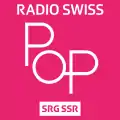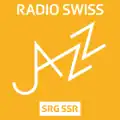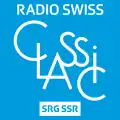 | |
 The SRG SSR headquarters in Bern | |
| Type | Broadcast radio, television and online |
|---|---|
| Branding | SRG SSR |
| Country | Switzerland |
First air date | 30 September 1922 (radio) 20 July 1953 (television) |
| Founded | 1931 by Four language-specific broadcasters |
| TV stations | SRG SSR television channels |
| TV transmitters | Digital cable (DVB-C), Internet streaming, IPTV, DTH satellite |
| Radio stations | SSG SSR radio stations
|
| Radio transmitters | Cable (DVB-C), FM, DAB+, Internet |
| 30.3 and 37.90% (2013) | |
Licence area | Switzerland |
| Headquarters | Bern, Switzerland |
Broadcast area | Switzerland |
Key people | Raymond Loretan, President Viktor Baumeler, VP Gilles Marchand, Director-General |
| Established | 1922 |
Former names | Schweizerische Rundspruchgesellschaft |
| Affiliates | |
| Group |
|
Official website | www |
| Subsidiary |
|
The Swiss Broadcasting Corporation[1] (German: Schweizerische Radio- und Fernsehgesellschaft; French: Société suisse de radiodiffusion et télévision; Italian: Società svizzera di radiotelevisione; Romansh: Societad Svizra da Radio e Televisiun; SRG SSR) is the Swiss public broadcasting association, founded in 1931, the holding company of 26 radio and television channels. Headquartered in Bern,[2] the Swiss Broadcasting Corporation is a non-profit organisation, funded mainly through radio and television licence fees (70%) and making the remaining income from advertising and sponsorship.
Switzerland's system of direct democracy and the fact that the country has four official languages (German, French, Italian and Romansh) mean that the structure of Swiss public service broadcasting is rather complicated. The actual holders of the broadcasting licences that enable SRG SSR to operate are four regional corporations:
- German Switzerland: Schweizer Radio und Fernsehen (SRF)
- French Switzerland: Radio télévision suisse (RTS)
- Italian Switzerland: Radiotelevisione svizzera di lingua italiana (RSI)
- Romansh: Radiotelevisiun Svizra Rumantscha (RTR)
These four corporations maintain SRG SSR as a joint central production and broadcasting association. The fifth business unit of the SRG SSR is the ten-language news platform Swissinfo.
Name
The association's official name is Schweizerische Radio- und Fernsehgesellschaft (SRG, formerly "Schweizerische Rundspruchgesellschaft") in German, Société suisse de radiodiffusion et télévision (SSR, formerly "Société suisse de radiodiffusion") in French, Società svizzera di radiotelevisione (SSR, formerly "Società svizzera di radiodiffusione") in Italian, and Societad svizra da radio e televisiun (SSR, formerly "Societad svizra da radio") in Romansh. The corporate name, SRG SSR, is derived from its initials in German and its initials in French, Italian and Romansh. In English, the organisation is known as the Swiss Broadcasting Corporation.[1] The moniker "idée suisse" (French for 'Swiss idea'), which refers to the public service mission of the organisation, was adopted in 1999 and was removed from the name in May 2011.
History

Europe's third public radio station started broadcasting from Lausanne in 1922, from the start based on a licence fee system. 980 licences were bought in 1923. Within a few years radio cooperatives working along the same principles had started throughout the country. In 1930 it was decided that radio was an important public service that should not be allowed to become a money maker for private interests, and that it needed to be structured on a federal basis. In 1931 SRG SSR was founded (see original names above), as a co-ordination organisation for the regional broadcast associations, and received the only licence to broadcast from the Federal Council. The same year it was agreed that all news reports in the new medium had to be provided by the Swiss news agency SDA, a decision that remained unchanged until 1971.
The first national transmitters began operating in 1931: Radio Sottens for French, Radio Beromünster for German, and 1933 Radio Monte Ceneri for Italian. In 1938 Romansh was recognised as the country's fourth national language, and the Zürich studios began broadcasting programmes in Romansh in between those in German. During the Second World War, SRG SSR filled an important function as a neutral, unbiased supplier of news, reaching far outside Switzerland's borders through shortwave transmissions. Radio Beromünster and Radio Monte Ceneri became known as the only free German and Italian-language radio stations in Europe.
In 1950, SRG SSR was one of 23 founding broadcasting organisations of the European Broadcasting Union. In 1939 television test transmissions started in Zürich. In 1953 regular TV transmissions started in German (from Zürich) – one hour per evening, five days a week – immediately attracting 920 early TV licence buyers. A year later, in 1954, French transmissions were broadcast from Geneva. For the Italian-speaking region, the programmes were re-transmitted with Italian subtitles until dedicated Italian studios were built in 1958. 50,000 TV licences were bought the first year.
In 1960, the company was renamed Schweizerische Radio- und Fernsehgesellschaft (and the equivalent names in the other languages - see above) to reflect the addition of television services. In 1964, the Federal Council allowed television advertising, as a means of keeping licence fees down. In 1966, the three main language communities were each given a second radio channel, in order to counter the effects of new commercial broadcasters outside the country, whose strong signals were reaching the Swiss population. In the same year, a dedicated Romansh broadcasting unit was created in Chur, using some of the new German-language second channel's broadcasting time. In 1968, colour television was introduced, and the number of licence fee payers passed one million.
In 1978, the radio channels started stereo transmissions. In 1983, the Federal Council relaxed the Swiss media legislation to permit local private and commercial radio channels. SRG SSR countered this threat by launching its third set of channels, aimed at a younger audience. In 1991, SRG SSR underwent a wide-ranging restructuring. The enterprise organised itself as a private industry association, structured as a holding company under Swiss company law. The name, SRG SSR idée suisse, was introduced in 1999. In 1992, Radio Rumantsch was separated from the German-language radio broadcaster that had housed the Romansh broadcasting activities since 1938, and in 1994, the Romansh TV activities were moved over as well and the Romansh company renamed itself Radio e Televisiun Rumantscha.
In 1997, SRG SSR started digital broadcasts via the Hot Bird (13 degrees East) satellite. It is encrypted from satellite due to copyright restrictions. SRG SSR Sat Access information channel stopped broadcasting in 2005. Since 2016, all channels have been broadcasting via satellite only in HD quality. All radio and SRF info TV channels are free-to-air via satellite.
On 3 June 2019, SRG SSR terminated digital terrestrial (DVB-T) broadcasts of all of its television channels due to the extremely low usage of digital terrestrial signals on television sets in Switzerland, which was part of a series of cost-saving measures partly brought about as a result of the 2018 "No Billag" popular initiative. Since then, reception of SRG SSR television channels is only possible mainly through digital cable, Internet streaming, IPTV and DTH satellite.[3]
Organisation
SRG SSR is headquartered in Bern. It is governed by a board of directors, appointed by a central council consisting of representatives of the four organisations.
Broadcasting is handled by five business units:
- Schweizer Radio und Fernsehen: handles German-speaking radio and television
- Radio télévision suisse: handles French-speaking radio and television
- Radiotelevisione svizzera di lingua italiana: handles Italian-speaking radio and television
- Radio Television Rumantscha: handles Romansh-speaking radio and television
- Swissinfo.ch: handles external services and the web portal swissinfo.ch
In addition, there are six subsidiary companies which produce TV programmes, teletext pages, book publishing, TV commercials, and audience research.
Until the termination of all terrestrial signals on 3 June 2019, the only television channels available in the whole of Switzerland were SRF 1, RTS Un, and RSI La 1, but the other channels are available in the linguistic regions represented by the broadcast language, and also nationally via cable, satellite and via the Internet. HD suisse was the first high-definition television channel of the SRG SSR. Programming came from the four language networks of SRG SSR.
SRG SSR is free to watch all television channels on the internet. However, it cannot be watched outside Switzerland due to broadcasting rights on all television channels. Only RTS Couleur 3 television channel it is watched over the internet outside of Switzerland. All radio broadcasts are listened to outside Switzerland.
Swissinfo
The former abbreviation SRI originally stood only for "Swiss Radio International", which was SRG SSR's international broadcasting arm (1935–2004),[4] aimed at expatriates and others interested in Switzerland. In October 2004, SRI ceased broadcasting on shortwave and satellite, and instead concentrated its efforts on its multimedia internet platform swissinfo.ch, which now takes most of the resources. The Swissinfo website is produced in English, French, German, Italian, Spanish, Portuguese, Arabic, Chinese, Russian and Japanese.
Swiss Satellite Radio
Swiss Satellite Radio (SSatR) is a radio company owned by SRG SSR that includes three stations: Radio Swiss Pop (pop music); Radio Swiss Jazz (jazz, soul and blues) and Radio Swiss Classic (classical music) all without interruptions. These stations have been on air since 1 September 1998.
 Radio Swiss Pop logo (2018)
Radio Swiss Pop logo (2018) Radio Swiss Jazz logo (2018)
Radio Swiss Jazz logo (2018) Radio Swiss Classic logo (2018)
Radio Swiss Classic logo (2018)
See also
References
- 1 2 "Statutes of the Swiss Broadcasting Corporation" (PDF). Swiss Broadcasting Corporation. Archived (PDF) from the original on 13 September 2022. Retrieved 13 September 2022.
- ↑ "Contact Archived 18 October 2017 at the Wayback Machine." Swiss Broadcasting Corporation; retrieved 9 December 2010. "SRG SSR General management Giacomettistrasse 1 3000 Berne 31."
- ↑ "Why is Switzerland switching off DTT?". 7 September 2018. Archived from the original on 23 September 2019. Retrieved 31 October 2019.
- ↑ swissinfo.ch, S. W. I.; Corporation, a branch of the Swiss Broadcasting (27 October 2004). "Swiss Radio International to stop broadcasting". SWI swissinfo.ch. Archived from the original on 25 October 2019. Retrieved 12 December 2018.
External links
- Official website
- SRG Deutschschweiz (SRG.D) - the German parent organisation (in German)
- SSR Suisse Romande (SSR.SR) - the French parent organisation (in French)
- Società cooperativa per la radiotelevisione nella Svizzera italiana (CORSI) - the Italian parent organisation (in Italian)
- SRG SSR Svizra Rumantscha (SRG.R) - the Romansh parent organisation (in Romansh)
- Edzard Schade: Swiss Broadcasting Corporation in German, French and Italian in the online Historical Dictionary of Switzerland, 19 July 2011.